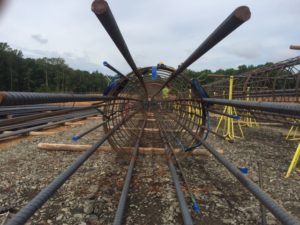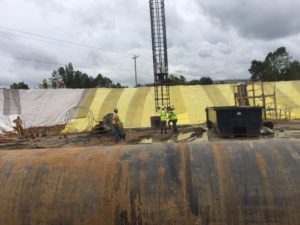Renewable energy, NASA and air traffic control towers – it’s all in a day’s work for Building & Earth.
The Raleigh, North Carolina, branch of Building & Earth is currently involved in a project at the Charlotte Douglas International Airport in Charlotte, North Carolina. The Building & Earth team is working with Archer Western Contracting (AWC) to build an Air Traffic Control Tower (ATCT) and a Terminal Radar Approach Control (TRACON) Building for the airport.
 The Federal Aviation Administration project includes the construction of the 370-foot-tall ATCT, and the construction of the 40,000-square-foot TRACON facility. The ATCT structure is supported a deep foundation system consisting of 49 drilled shaft piers that are approximately 52.5 feet long. The shafts are reinforced with eight #14 bars with #5 hoops every 12 inches. The test shaft was load tested using an Osterburg Load Cell (O-Cell). The load test showed a capacity of 1,400 kips. The pile cap for the tower is an 80-foot, cast-in-place concrete mat. From the top of the mat foundation, a series of precast panels will be set into place for each level of the tower, which boasts 17 levels to achieve the overall height of 370 feet.
The Federal Aviation Administration project includes the construction of the 370-foot-tall ATCT, and the construction of the 40,000-square-foot TRACON facility. The ATCT structure is supported a deep foundation system consisting of 49 drilled shaft piers that are approximately 52.5 feet long. The shafts are reinforced with eight #14 bars with #5 hoops every 12 inches. The test shaft was load tested using an Osterburg Load Cell (O-Cell). The load test showed a capacity of 1,400 kips. The pile cap for the tower is an 80-foot, cast-in-place concrete mat. From the top of the mat foundation, a series of precast panels will be set into place for each level of the tower, which boasts 17 levels to achieve the overall height of 370 feet.
The TRACON building is also a precast concrete building, but is supported on shallow footings and a slab-on-grade floor system. The TRACON building is supported by nearly 20 feet of structural fill that was placed to grade to achieve the planned elevations. The TRACON building will be connected to the new tower by an enclosed, pre-cast concrete “link.”
 “Our team worked very closely with the AWC estimating group to develop the quality control plan, which was one of the most heavily weighed factors in being awarded the contract,” said Kurt Miller, P.E., Building & Earth North Carolina branch manager. “Our scope of service for the project includes performing construction civil, structural and architectural submittal and shop drawing reviews, providing monthly, “over-the-shoulder” quality control peer review, and performing the materials testing and special inspections.”
“Our team worked very closely with the AWC estimating group to develop the quality control plan, which was one of the most heavily weighed factors in being awarded the contract,” said Kurt Miller, P.E., Building & Earth North Carolina branch manager. “Our scope of service for the project includes performing construction civil, structural and architectural submittal and shop drawing reviews, providing monthly, “over-the-shoulder” quality control peer review, and performing the materials testing and special inspections.”
According to Miller, during the installation of the drilled shaft, the Building & Earth team was performing monitoring of the drilled shaft construction. This included identifying the depth to rock and water, recording drill rates and times, and performing concrete testing as the shafts were placed. Once the shafts were complete, and prior to setting the reinforcing steel, gas and radon testing was performed for selected shafts. The gas testing was performed to determine if explosive gases were present in the shaft, and a 48-hour radon test was performed. The Building & Earth team was also prepared to perform digital videography of the shaft walls. However, due to the presence of shallow groundwater, and the fact that the shafts excavations were sleeved, the videography was not able to performed.
For more information on the project, click here.

